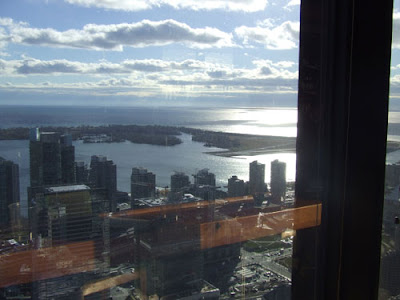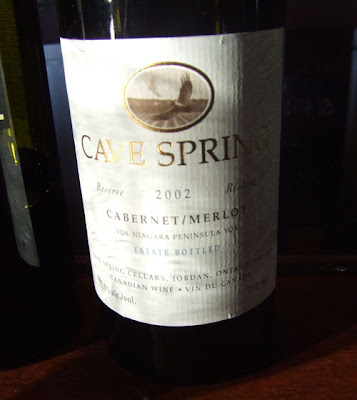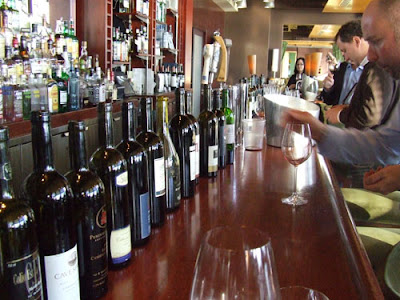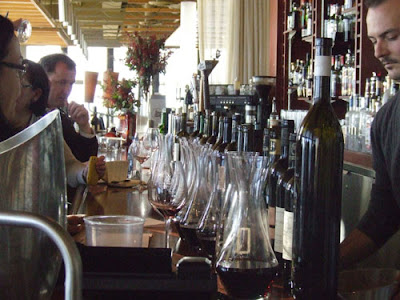Viopalooza: Vio the Rhône-born Divo Shows What it can do when it Goes to Ontario & BC Finishing School
After the success of the #Tastegris Twitter tasting a group of oenophiles recently came together to taste the best of Ontario Viognier. Yes, the favoured and sometimes only white grape permitted in certain regions of France's Northern Rhône has slowly found some traction in Niagara—enough to provide a solid line-up for #Viopalooza. As is the nature of these Twitter tastings the line-up is announced ahead of time and people are encouraged to taste along and share their thoughts with the tasters and those tasting vicariously on Twitter using the above hash tag. Naturally that makes blind tasting virtually impossible but if you want to build a community the social interaction of allowing everyone to participate is far more important than trying to isolate any bias.
Regardless of Viognier's exact origins it seems to have found a home in the Northern Rhône, in particular Condrieu where south facing slopes on heat retaining granite soils combine with hot summers and cool wet winters to produce world renown wines. But even in the grape's home producing a fine wine is a challenge. The crop sizes are dubious. Yields must be kept low to maintain varietal character. And there is a very tight window after the grapes reach the right sugar level and then develop the flavour & volatile aroma compounds that are intrinsic to good Viognier. So given the relatively short and humid summer growing seasons and cold winters in Niagara it almost seems like madness to try grow this diva/divo of a grape. But when it's done right the combination of that ethereal floral bouquet and rich without being heavy mouth-feel is really unparalleled.
 |
| From VIopalooza |
Chåteau des Charmes has a long history of experimentation whether it be different trellising systems, planting viniferia in the early years or being one of the first to use wind machines to protect tender spring buds against frost damage. So it should come as no surprise that the winery has allocated a relatively small block (one acre) to Viognier since the early 1990s. According to Michelle Bosc the key to producing good Viognier in Niagara is aggressive thinning (40-60% of the bunches are dropped every year to promote ripening). And on the winemaking side it's all about being as gentle as possible limiting the movement of the wine and keeping it in stainless steel. This opinion was echoed by Jay Johnson and Marlize Beyers winemaker at Hidden Bench. Johnson, who assists with winemaking and can often be seen out in the vineyards tending to the vines, says the winery inherited some when it purchased the Locust Lane Vineyard. Given the naturally low yields of Viognier and the very low yields Hidden Bench commits itself to there are plans to grow more. For Beyers the key to making Viognier is to minimise movement using gravity wherever possible because she believes that any movement even necessary ones like tank to bottle only results in a loss of more of the aromatics that are key to variety's identity. Richie Roberts, the winemaker at Fielding first encountered Viognier when he was working as the assistant winemaker at Stratus. Although he uses stainless steel at Fielding he feels there is a place for neutral oak especially if the goal is to impart some nuttiness or leesy character. Similarly Bosc says some malolactic conversion/fermentation can add to the mouthfeel but given Viognier's naturally low acid and high sugar you need to be careful when using it. So how did the wines taste?
Overall it was was a good showing with the Canadian wines exhibiting the variety's distinctive floral character. The 2008 Chåteau des Charmes was a favourite. It had aromas of peach and rose petal as well as a full mouthfeel—all classic characteristics of Viognier. Another favourite was the 2009 Fielding with aromas and flavours of juicy peach and orange blossom that really shone through. Only 10% of the fruit came from the estate vines which were recently pulled because Roberts felt they weren't performing well in that location. The other 90% comes from a Niagara-on-the-Lake vineyard where Roberts has established a long term relationship and the Fielding crew performs the vineyard work.
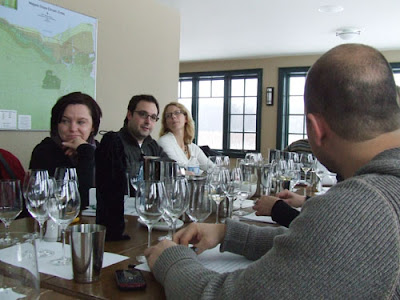 |
| From VIopalooza |
Given that parts of BC's Okanagan are a virtual desert the climate has the potential to get closer to the Rhône than Niagara. And the wines didn't disappoint with the tasting's most praised wine coming from the Okanagan. Selling between $15-20 the Jackson Triggs' 2008 Silver Series was fresh containing ripe peach and orange blossom flavours. The mouthfeel was full with good weight. It hit all the points you expect from a Viognier and did so at a great price point. It was also interesting to taste the 2008 Sandhill Small Lots Program Viognier one year removed from being awarded white wine of the year at the Canadian Wine Awards. Full of peach aromas with floral blossoms the best feature of the wine was the full rich mouth feel. If there was a criticism it was that the wine which was picked late and fermented dry was really quite hot and tasted as if it had more alcohol than the 14% listed. But the mouth feel alone which was rich without being heavy much like a good soufflé, could make you understand the accolades the wine received. However my favourite Okanagan wine and one that received considerable praise around the table was a 2008 83% Viognier 17% Marsanne blend from Rhône specialist Stag's Hollow. Surprisingly this wine's mouthfeel exceed even the Sandhill in its richness. The nose was full of beautiful aromas like walking through an orchard in bloom just after a late afternoon sun shower. There was also a honeyed note which complemented the the slightly off-dry finish—kept in balance by good acidity. Interestingly it was barrel fermented in new oak and aged for eight months. It was nice to see that the practice added structure to the wine and did nothing to hinder the aromatics.
Another interesting observation that sparked a discussion at the tasting was that Viognier seemed to be wine that you want to drink upon release/purchase or shortly there after (before the next vintage is released). The wine that started this discussion was a 2006 Fielding. The colour had moved from the pale lemons of the fresh Viogniers to a medium-gold honeyed colour. Although there were still some floral elements the dominat aroma was that of burnt sugar which as Del Rollo pointed out is something that is immediately identifiable to someone who has made creme brulée before. Although a touch oxidised and slightly golden the 2006 Hidden Bench was much fresher in comparison with honeyed peach flavours. The acid seemed to be dropping in relation to newer vintages but it still continued to provide a refreshing balance. The 2007 vintage with 13.4% alcohol felt a little hot in comparison. It possessed strong floral aromatics but it had a background of barrel notes. Although all Hidden Bench Viogniers are barrel fermented and aged in neutral oak, the barrel character showed through the most on the 2007. The 2008 showed a little more in the way of floral aromatics with juicy peach and orange blossoms and a slight spicy character. The 2009 was a little less expressive in its aromatics showing a light perfumed note. What made this standout was the high acidity. Much higher than any of the other examples, it was closer to the acid levels of a cold climate Sauvignon blanc than the other Viogniers. Whether you liked the style or not is a separate issue, but it was certainly interesting to taste vintage variation. Hidden Bench uses natural ferments and it barrel fermented these Viogniers in neutral oak through all vintages so with vinification being largely the same you could really taste the differences a growing season can impart on a variety.
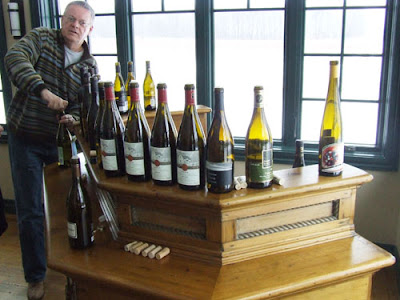 |
| From VIopalooza |
The last example was a Malleval, Condrieu grown on those famous heat retaining granite slopes from Pierre Gaillard. This wine was a bit of an enigma with many hard to describe flavours and aromas. It was surprisingly far from the most aromatic. However being the last wine poured, it had been open for more than two hours and other tasters had mentioned that the aromatics had dissipated a bit since opening. That said it did possess a wide range of interesting flavours and aromas. Mint, pickles and lactic acid nuances joined floral and burnt sugar flavours and aromas. The mouthfeel had strength and presence while defying heaviness much like a ballerina mid-leap. The vinfication notes on the page write about a controlled barrel fermentation and aging in tightly grained French oak with only 10% being new. Although oak really played no prominent role in the flavour profile it no doubt added something to the wine's feel.
It seems that the richness and complexity of the Condrieu exceeded anything from Niagara or the Okanagan. When the question was asked why this might be happening, Bosc chimed in with a simple but complex answer: vine age. The consensus is that Viognier vines are late bloomers really only showing what they are truly capable of after 20 years. Given that a life span of 30 years is considered quite good in Niagara due to harsher winters it seems that it's an uphill battle to be able to compete on the same level as those Rhône wines. That being said Viognier here shows beautiful aromatics that are a hallmark of the variety but the style is lighter and crispier than those wines. This situation of contrasting styles exists throughout the wine world. I would argue that a Grand Cru Chablis from Domaine Christian Moreau is neither inferior nor superior to Chateau Montelena when it comes to Chardonnay. Sure many will prefer one over the other but if you really analyse a well made old world example versus a new world example a wine lover will probably find them just as appealing but in a different way.
 |
| From VIopalooza |
The other interesting element which may also help explain the difference between Condrieu and the Niagara and Okanagan Viogniers is clones. It seems that growers in Condrieu say the clone of Viognier used in their vineyards is thought to be different than the one used in the southern Rhône and everywhere else Viognier is grown. The propagation of this clone (642), which came at time when the variety was near extinction, is popular in the new word and it is believed to be a relatively high producer with larger berries but contains less of the distinctive aromatics in comparison to the one used in Condrieu. It's tough to say exactly what clone everyone is growing but Hidden Bench, Chåteau des Charmes and Fielding all use 642. Given Canada's strict importation laws designed to minimise the risk of foreign viruses the clone availability is usually very limited so it's very possible that most if not all of the Viognier found Niagara and BC is 642. Without a direct virtually side-by-side planting it's tough to say whether the clones are as different as the Condrieu growers & producers say. After all in the terroir obsessed world of French wine anything you can do to make your wine as unique as possible is a huge advantage. That said even if you can set aside the climatic and terroir conditions between Condrieu, Niagara and the Okanagan, the clone could be another interesting layer in the differences between the Viogniers. Until and likely even after science definitively sorts it out I'll be more than happy to to give my feedback on the debate through sensory evaluation of what's in the glass.
